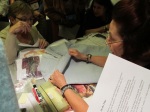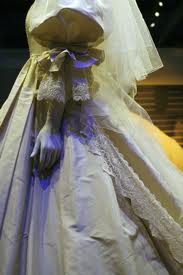 September is here! On the one hand it means a melancholy feeling because summer is coming to an end and we’re heading to cooler temps. But on the other hand, September is a CELEBRATION OF SEWING! September is celebrated as National Sewing Month and is co-sponsored by the Sewing & Craft Alliance and the American Sewing Guild.
September is here! On the one hand it means a melancholy feeling because summer is coming to an end and we’re heading to cooler temps. But on the other hand, September is a CELEBRATION OF SEWING! September is celebrated as National Sewing Month and is co-sponsored by the Sewing & Craft Alliance and the American Sewing Guild.
A Brief History of National Sewing Month
 In September 1982, President Ronald Reagan signed Proclamation #4976, declaring that September as National Sewing Month. The proclamation recognized the tens of millions of Americans home sewists and “the skill and the self-reliance which are so characteristic of this Nation.” This was followed with successive annual proclamations by President Reagan during his terms. But in 2005, the request for a proclamation was not accommodated. However, even without a Presidential proclamation, September continued to be supported and promoted as National Sewing Month by various organizations.
In September 1982, President Ronald Reagan signed Proclamation #4976, declaring that September as National Sewing Month. The proclamation recognized the tens of millions of Americans home sewists and “the skill and the self-reliance which are so characteristic of this Nation.” This was followed with successive annual proclamations by President Reagan during his terms. But in 2005, the request for a proclamation was not accommodated. However, even without a Presidential proclamation, September continued to be supported and promoted as National Sewing Month by various organizations.
In 2008, the American Sewing Guild joined forces with the Sewing & Craft Alliance to continue the promotion of National Sewing Month and provide a central location for the distribution of National Sewing Month information and materials to organizations, educators, sewing enthusiasts and anyone else interested in promoting and/or participating in activities for National Sewing Month.
Celebrate With Sewing: Sew For The Love Of It Contest
 National Sewing Month is celebrated with a contest to showcase and encourage sewing creativity and imagination. This year’s theme is “Sew For the LOVE of it!”
National Sewing Month is celebrated with a contest to showcase and encourage sewing creativity and imagination. This year’s theme is “Sew For the LOVE of it!”
The contest runs through September 30, 2011. Official rules and entry can be found on the National Sewing Month website. Here’s what you should be thinking:
“Show us what YOU love to sew! You choose the project, whether it’s an article of clothing, a toy, something for your home, an accessory, a quilt, or even an item for your car or boat. Whatever you decide to create, show your love with a within the project. It can be heart fabric, a pillow shaped like a heart, heart embroidery, heart-shaped pockets – it’s completely up to you. The item you enter must be hand-crafted and utilize fabric, thread and sewing machine and there MUST be a visible heart somewhere on the project itself. Whatever you choose to sew, just make sure we see the expression of your love of sewing!”
Think about using National Sewing Month in your neighborhood group challenge this month. If you have pictures, be sure to post them to the Members’ Projects album or email me to post them.
Follow National Sewing Month on Twitter

The National Sewing Month is on Twitter, @sewingmonth. Watch their tweets for daily giveaways and tutorials posted to the National Sewing Month website.
Don’t forget to follow us on Twitter, @sewchicago. Watch for our special National Sewing Month tweets with the hashtag “#NatSewMo”. We and other sewists around the Twitter-sphere are using the hashtag to share our enthusiasm for sewing!
Filed under: Events, Sewing history | Tagged: American Sewing Guild, couture sewing, crafting, embellishment, embroidery, fabric, felted food, felting, heirloom sewing, holiday sewing, home dec, machine embroidery, quilting, sewing resources, sewing skills, tailoring, teaching sewing | Leave a comment »









 The American Sewing Guild National Conference was held in Los Angeles this year. Eleven of our Chicago chapter members attended and filled their days with learning new techniques and meeting old and new friends. Below are some pictures and tidbits that our President, Connie G. sent back.
The American Sewing Guild National Conference was held in Los Angeles this year. Eleven of our Chicago chapter members attended and filled their days with learning new techniques and meeting old and new friends. Below are some pictures and tidbits that our President, Connie G. sent back.


















 Baseball season has opened. The White Sox home opener is today; the Cubs opened at home last week. Baseball is the signal of warm weather. Do you go outside to enjoy the weather or do you stay inside from the sun and heat to continue sewing?
Baseball season has opened. The White Sox home opener is today; the Cubs opened at home last week. Baseball is the signal of warm weather. Do you go outside to enjoy the weather or do you stay inside from the sun and heat to continue sewing?




